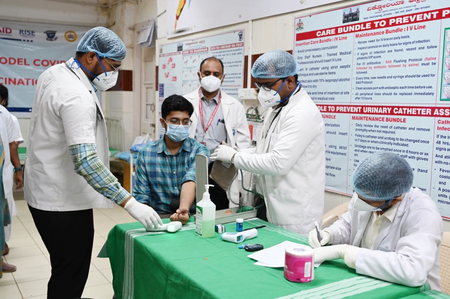New Delhi, October 17 (IANS). Researchers in India have created a unique way to deliver TB medicine directly to the brain. This unique drug delivery method can effectively treat brain TB. TB of the brain poses a life-threatening condition with high mortality. When TB affects the brain, it is called central nervous system TB (CNS-TB). This is one of the most serious forms of TB, often causing serious complications or death.
One of the biggest challenges in treating CNS-TB is a protective barrier called the blood-brain barrier (BBB). This hinders the TB medicine from reaching the brain. This barrier prevents many drugs from entering the brain, limiting their effectiveness. Conventional treatments include high doses of oral anti-TB drugs, but these often fail due to damage to the BBB.
Scientists of the Institute of Nano Science and Technology (INST), Mohali, an autonomous institute of the Central Department of Science and Technology (DST), have done a new research in this regard. According to research, microscopic particles made from a natural substance called chitosan have been used to deliver TB medicines directly to the brain through the nose without crossing the BBB. Here the team of scientists under the leadership of Rahul Kumar Verma developed chitosan nano-aggregates. These are small clusters of nanoparticles made from chitosan, which is a biocompatible and biodegradable substance.
These tiny particles, known as nanoparticles, were then formed into slightly larger groups called nano-aggregates, which are designed to be easily delivered through the nose. They can administer TB drugs like isoniazid (INH) and rifampicin (IFIF). The drug delivery technology was used for nose-to-brain (N2B) drug delivery, which utilizes the olfactory and trigeminal nerve pathways in the nasal cavity to bypass the BBB.
By delivering drugs via the nasal route, nanoaggregates can deliver drugs directly into the brain, significantly improving drug bioavailability at the infection site. Furthermore, chitosan is known for its mucoadhesive properties. It adheres to the nasal mucosa, helping the nano-aggregates to remain in place and prolonging the drug’s release time, thereby increasing its therapeutic effectiveness.
When tested in the laboratory, these particles stuck well inside the nose. These were able to deliver much more drug into cells than regular TB drugs. The new treatment was tested on mice infected with TB. Nasal delivery of these nano-aggregates reduced the number of bacteria in the brain by approximately 1,000-fold compared to untreated mice. This study is the first of its kind to demonstrate that brain TB can be effectively treated by delivering TB drugs through the nose using these advanced particles.
The institute says the new treatment not only ensures that the drug reaches the brain but also helps reduce inflammation caused by infection. The discovery, published in the journal Nanoscale (Royal Society of Chemistry), has the potential to significantly improve the treatment of people with brain TB and could aid faster recovery. It can also be used in the treatment of other brain infections, neurodegenerative diseases (such as Alzheimer’s and Parkinson’s), brain tumors and epilepsy by ensuring effective delivery of medication to the brain.
–IANS
GCB/ABM






